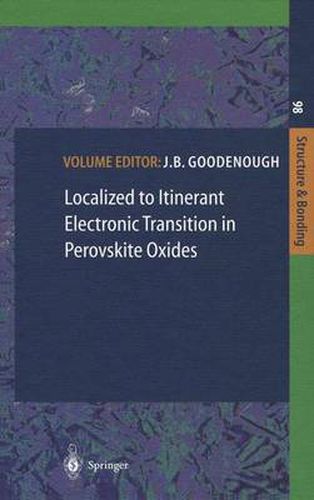Readings Newsletter
Become a Readings Member to make your shopping experience even easier.
Sign in or sign up for free!
You’re not far away from qualifying for FREE standard shipping within Australia
You’ve qualified for FREE standard shipping within Australia
The cart is loading…






This title is printed to order. This book may have been self-published. If so, we cannot guarantee the quality of the content. In the main most books will have gone through the editing process however some may not. We therefore suggest that you be aware of this before ordering this book. If in doubt check either the author or publisher’s details as we are unable to accept any returns unless they are faulty. Please contact us if you have any questions.
Interest in the transition metal oxides with perovskite related structures goes back to the 1950s when the sodium tungsten bronzes NaxWO3 were shown to be metallic [1], the system Lal_xSr~MnO3 was found to contain a ferromagnetic conductive phase [2], and La0.sSr0.sCoO3 was reported to be a ferromagnetic metal, but with a peculiar magnetization of 1.5 #a/Co atom [3]. Stoichiometric oxide perovskites have the generic formula AMO3 in which the A site is at the center of a simple cubic array of M sites; the oxide ions form (180 4)) M O M bridges to give an MO3 array of corner shared MO6/2 octahedra and the larger A cations have twelvefold oxygen coordination. Mismatch between the A O and M O equilibrium bond lengths introduces internal stresses. A compressive stress on the MO3 array is accommodated by a lowering of the M O M bond angle from 180 to (180 4)); a tensile stress on the M O M bonds is accommodated by the formation of hexagonal polytypes [4].
$9.00 standard shipping within Australia
FREE standard shipping within Australia for orders over $100.00
Express & International shipping calculated at checkout
This title is printed to order. This book may have been self-published. If so, we cannot guarantee the quality of the content. In the main most books will have gone through the editing process however some may not. We therefore suggest that you be aware of this before ordering this book. If in doubt check either the author or publisher’s details as we are unable to accept any returns unless they are faulty. Please contact us if you have any questions.
Interest in the transition metal oxides with perovskite related structures goes back to the 1950s when the sodium tungsten bronzes NaxWO3 were shown to be metallic [1], the system Lal_xSr~MnO3 was found to contain a ferromagnetic conductive phase [2], and La0.sSr0.sCoO3 was reported to be a ferromagnetic metal, but with a peculiar magnetization of 1.5 #a/Co atom [3]. Stoichiometric oxide perovskites have the generic formula AMO3 in which the A site is at the center of a simple cubic array of M sites; the oxide ions form (180 4)) M O M bridges to give an MO3 array of corner shared MO6/2 octahedra and the larger A cations have twelvefold oxygen coordination. Mismatch between the A O and M O equilibrium bond lengths introduces internal stresses. A compressive stress on the MO3 array is accommodated by a lowering of the M O M bond angle from 180 to (180 4)); a tensile stress on the M O M bonds is accommodated by the formation of hexagonal polytypes [4].